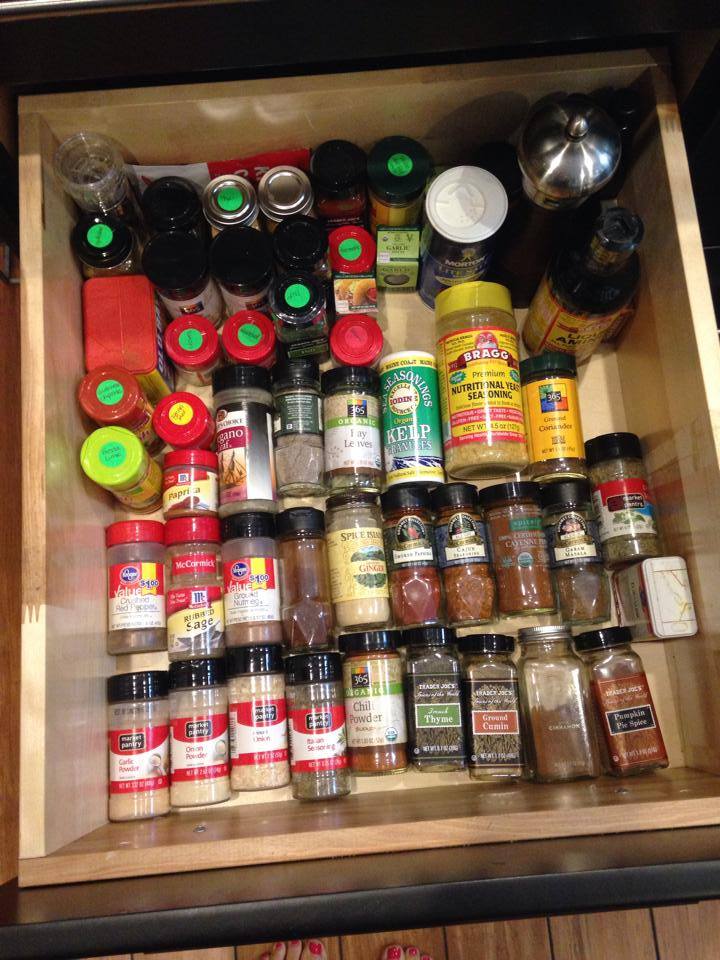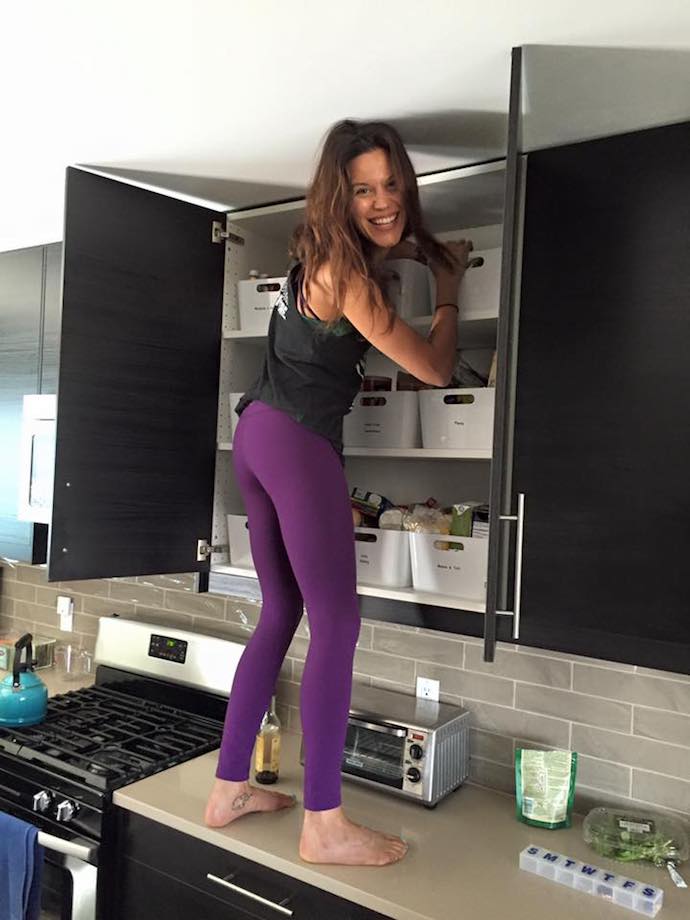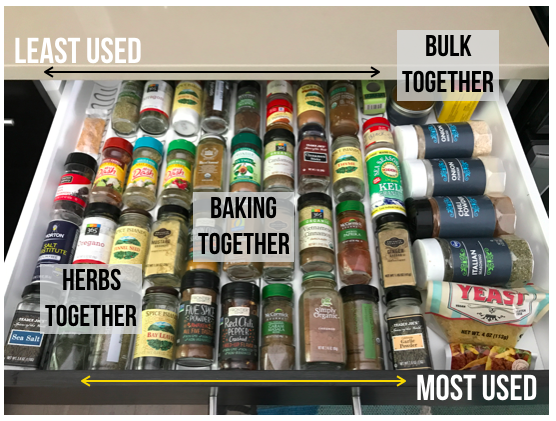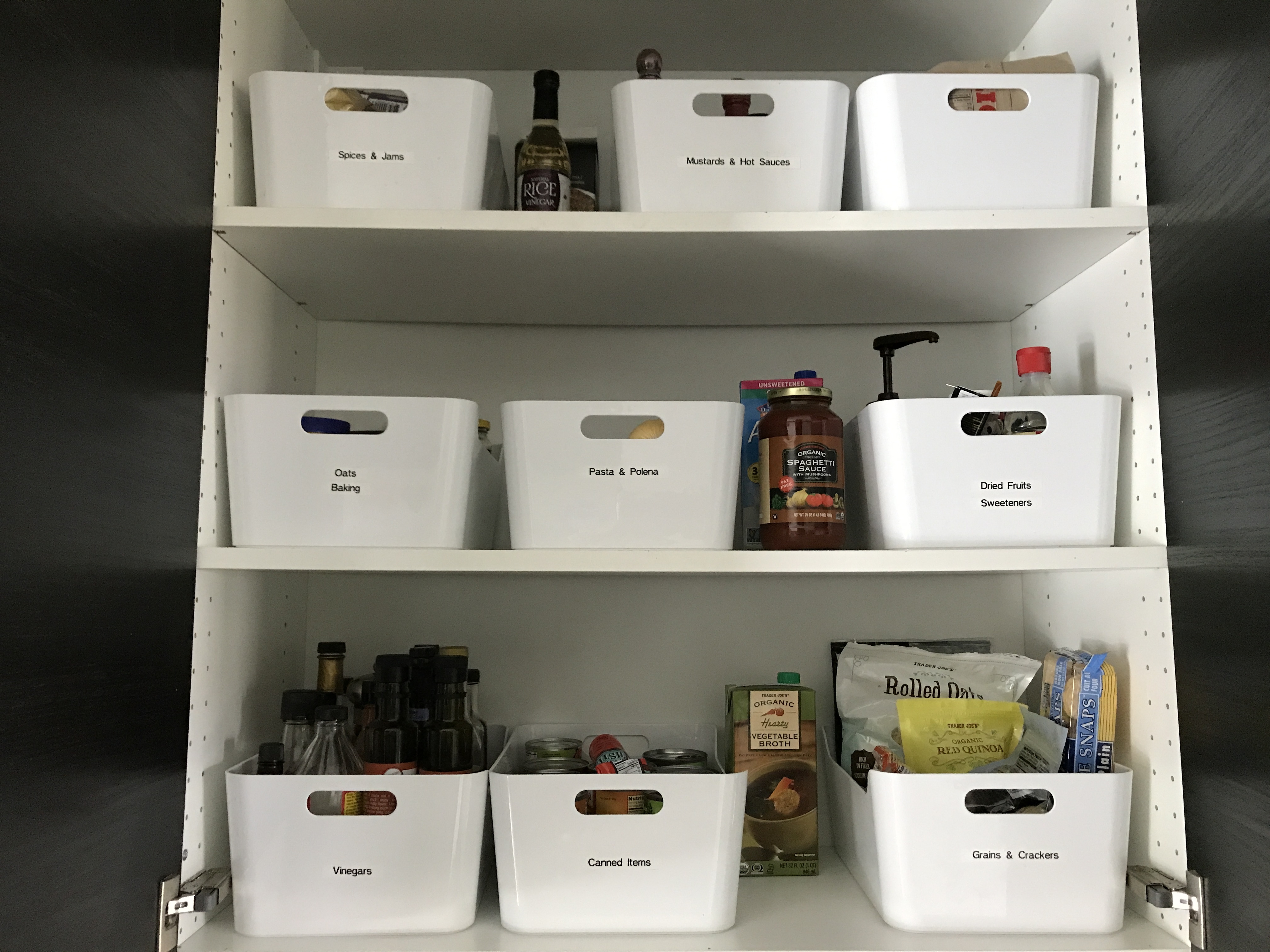Even if you don’t have great knife skills, you can be a faster cook.
*IF* your kitchen is organized for efficient cooking.
Let me reiterate:
You are not ‘slow’ at cooking because you lack skills…
The problem is:
- You don’t know where everything is (mental inventory)
- Your kitchen isn’t organized well for cooking
MENTAL INVENTORY
POP QUIZ!!
Where are your chickpeas? Where is your slotted spoon?
If your answer isn’t something like “Chickpeas are on the bottom shelf of my pantry, all the way to the right, sitting next to the canned tomato sauce and white beans” and “My slotted spoon in in the left basket inside the middle drawer next to the stove along with my spatula and soup spoon”
You’ve failed.
If you can’t visualize right now where specific items are, we have a problem.
Try it—conjure up the exact location of these items in your head:
- Saucepan lid
- Whisk
- Ground cumin
- Pot holder
- Colander
- Tongs
- Baking powder
- Vinegar
- Ladle
Being a zippy cook has little to do with knife skills or cooking skills.
“Skills” help, but the real speed secret is GEOGRAPHICAL KNOWLEDGE.
Having a mental inventory of EXACTLY where each spice or spatula “lives”
Think about how much faster you walk when you know exactly where you are going.
Compared to when you’re trying to find a place for the first time.
SEE??
Think about the last time you went to a new grocery store or a mall.
You had no idea where anything was. You stumbled around trying to orient yourself. Maybe you consulted a map, looked at the signs over the aisles, or asked for help...
But the next time you went there??
You knew EXACTLY where you needed to go and made a beeline for that store or aisle. You were in and out in minutes.
THIS has to be your kitchen reality if you want to be fast.
PLUS Knowing where everything is builds confidence by eliminating anxiety, which makes you faster in return.
Those extra zen vibes allow you to actually BUILD skills too.
You just can’t learn when you’re stressed out.
KITCHEN ORGANIZATION
For all my fellow OCD’ers who are thinking “But I already am SO organized!”
There is organization, and then there is organization for efficiency.
They are not always one in the same.
Anyone who saw The Pursuit of Happyness might remember how the main character, Chris Gardner, worked desperately to squeeze extra minutes and productivity into his cold calling efforts. In that scene, Gardner describes how he was able to gain EIGHT minutes of extra time per day by simply not hanging up the phone in between calls.
That single quote ignited my love affair with productivity and efficiency.
How I Organize My Kitchen for Quicker Cooking
There’s a statistic that the bigger someone’s kitchen is, the less likely they are to use it.
I’m not sure about that, although I did get started in this tiny space:

That’s the kitchen where I wrote my first cookbook. (I know!)
The second one wasn’t much better:

I’ve upgraded since, but find even with more space now, I don’t actually use the space.
I still huddle in the same area because that’s how I’m efficient.
Home kitchen organization from someone who cooks every day...
My focus is functionality.
I set up my kitchen in a way that makes it easier to cook.
Efficiency trumps feng shui.
Here's an example:
I have a spice DRAWER.

I drool all over myself when I see spices on display like this at Ikea, but it's just not realistic or functional for me.

#1 I have waaaay more spices than that.
#2 You don't use your spices “equally.”
As much as my OCD brain likes uniformity...
It's not FUNCTIONAL with spices.
I use some spices (ex: garlic powder, chili powder) so frequently that I have to buy them in big bulk containers.
If I tried to keep my spices all modest-like in those cutesy containers, I would have to refill my "staple spices" every week (umm... no).
I would also have to find a second storage space for the extras AND remember where that storage space is.
This causes additional hurdles and friction zippy cooks don't need.
Functionality demands you keep your spices (or at least the 20 most utilized) in one spot, in appropriately sized containers based on frequency of use.
Having the same size spice containers is pure vanity.
- You have plenty of art and decoration in your home already.
- You don't need your spice rack to be an artistic expression.
- Your spices and herbs have ONE job—flavor your food.
Anything else is a distraction that might prevent you from cooking, even if the friction isn't obvious.
#3 Your spices have to be at your fingertips.
The closest available wall space for the Ikea set-up above (or any kind of spice rack really) isn't anywhere near the stove.
In 99% of kitchens, the stove is surrounded by cabinets and drawers.
That means your spice solution has to work WITH cabinets.
Your spices have to be at your fingertips, literally!
IMHO, even if your fridge or pantry is "nearby" it is still too far away to be home to your spice.
If you have to turn around or side-step even one step, that's friction and any friction reduces cooking likelihood and efficiency.
Shallow kitchen drawers are perfect for spice storage.
The Variera drawer inserts from Ikea ($3.99) are awesome because they keep the spice jars facing up and not falling over or rolling into a mess.
I’ve experimented with lazy Susan’s but those often resulted with the spices falling on my head or falling into whatever I was cooking.

I don’t think “shelves” mounted to cabinet doors make sense for most people because you’d need a lot of them, and you’d also have to be really, really tall.
I’m 5’7” and I wouldn’t be able to reach spices mounted to my cabinets.
Now let’s talk about PANTRY ORGANIZATION
When I posted this picture of my kitchen, everyone asked how I organized it.

The house I’m currently living in doesn’t have a pantry, so I dedicated two cabinets to it.
Note: I have my dishes in the other “top” (above the counter) cabinet, with my pots and pans and appliances (i.e. toaster and blender) in the “lower” (below the counter) cabinets. I leave nothing on my counter—it’s free of all clutter. This means all appliances have a “home.” Even in my smaller apartments, I practiced this put-away policy, sometimes storing my appliances in my bedroom closet!
The more cluttered my counters are, the less I cook or want to. Clean counters are much more inviting and calming.
BACK TO MY PANTRY ORGANIZATION:
I have 9 baskets (that’s all that would fit).
I used baskets for two reasons:
#1 they contain the chaos.
#2 it makes cooking easier.
If I’m baking, for example, I can pull down the baking basket and know I have everything I need.
This reduces anxiety but also ensures I’m not going to spend three minutes looking for the canisters of baking powder that fell behind a stack of canned tomatoes.
The baskets also tell EVERYONE in the house where things go.
So many items were “lost” or misplaced because someone (including me!) did not put it back where they found it.
I can’t even begin to tell you how much this basket system has DRAMATICALLY reduced duplicate purchases.
It’s also saved me from HOURS of that annoying frustration where you KNOW you have the thing but can’t find it (and you check every place three times).
The basket system is also my sneaky way of getting help with chores.
“I don’t know where things go” was a common excuse why someone couldn’t help me clean up or put groceries away. NOT ANYMORE ;)
This organization also had the surprising benefit of inspiring my husband to cook.
He started offering to make pancakes (or breakfast) on the weekends…
A few nights I came home and found him cooking dinner…
We soon realized one of the reasons he didn’t cook much before was because he didn’t know where things were.
That created cooking anxiety.
My husband also didn’t want to bother me by asking where things were—the whole point of him cooking was so I could relax.
He would also worry he might accidentally move something or put it back in the wrong place that would make my life harder later…
ALL OF THIS IS ELIMINATED with functional organization.
Knowing EXACTLY where your stuff is provides confidence.
MY BASKETS:
Bottom Shelf: Vinegars, Canned Foods, Grains/Crackers
Middle Shelf: Dried Fruit/Sweeteners, Oats + Baking, Pasta/Polenta
Top Shelf: Mustard/Hot Sauce (extras), Spices (extra), Etc. (unlabeled)
These groupings may or may not make sense for you. I find this part is very “personal” though I think everyone would benefit from a “Baking” basket! (details below)
The “most used” items are on the bottom shelf with things not used as much in the middle, and all our “extras” (overflow) on the top shelf.
For example, I use my vinegars and canned goods every day, or just about every day, but I don’t bake every day. Thus for me, it makes sense to have baking items in the middle row.
Same with the grains and crackers. I’m always cooking rice, or quinoa, or grabbing a few crackers to throw into our lunch bags or to serve with soup. I use those more than the baking items, or the sweeteners, or the pasta, which is why they get prime retail space.
The top shelf is strictly storage.
Since I can’t reach those items without standing on the counter (reference earlier picture LOL), I don’t keep anything up there that I would need to use.
That top shelf is only a “holding ground.”
Once sometime is removed from there, it stays somewhere else afterward.
So what’s up there exactly? I buy my condiments (mustard, hot sauce, ketchup) through Amazon prime, which means I have to buy in bulk (4-6 bottles at a time). This top shelf is where I keep them.
Same for my spices. I buy most of them in bulk. I keep the big bags up top and refill the smaller canisters in my spice drawer.
I also HATE when I run out mid-recipe so having “backup” relieves more of that cooking anxiety.
Baking Basket: Flours, cornmeal, baking powder, baking soda, vanilla extract, almond extract, yeast packets, cornstarch, unsweetened cocoa, chocolate chips.
If I’m going to bake ANYTHING, I know to pull down this basket and feel instant relief that everything I’m going to need is already collected right here.
Note: I keep my oats in this basket because I generally only use oats when I’m baking. If my family ate oats (i.e. oatmeal) I would keep the tub on the bottom shelf between 2 baskets.
Oatmeal gives my husband horrible acid reflux, so we don’t eat them like we used to, and consequently, it doesn’t make sense to have an item we don’t use taking up prime space.
The reason I added “oats” to this basket’s label was so guests who were staying here could find the oats easily for their breakfast :) I wouldn’t have made the distinction otherwise.
Because I have a lot of different sweeteners (raw sugar, brown sugar, powdered sugar, agave nectar, honey, etc.) I couldn’t keep them with my baking items. They’re in their own basket instead, along with my raisins and dates which also often act as sweeteners.
THINGS TO ASK YOURSELF BEFORE ORGANIZING:
- What do I use most?
- What do I use least?
- What items do I use together?
Let’s talk about the SPICE DRAWER
Instead of a spice rack, I have a spice drawer.
I find this makes it so much easier to find my spices (have a mental inventory of them) plus reaching over my store meant I often dropped entire canisters into whatever I was cooking because I’m clumsy.
Here’s my drawer in our last place:

It was very deep.
Here’s my current drawer:
It’s very shallow, but longer.
Instead of alphabetical, my spices are grouped together by commonality.
Specifically, all the herbs are together, all the “baking” spices together.
I also have the spices I use the most closest to the stove.
That means my garlic powder, onion powder, Italian seasoning, Chili powder, ginger, and cinnamon are the closest to the stove.
Depending on the food your family likes, you may have different “mostly used” spices.
Much like my “pantry” I have the other commonly used spices at the bottom, and the least used at the very top. This way, I only have to open the drawer a little bit for my most used.

This too provides a terrific “mental inventory” which makes cooking faster and easier.
If the recipe calls for cumin, and I realize I forgot to grab it before I started, no biggie.
I know EXACTLY where my cumin is and go to it. I’m not hunting around looking for it, worrying my dinner is burning while I’m on a spice safari.
You may have noticed my spices are to the left of my stove…
When I first moved in, I had my spices in the drawer to the RIGHT of my stove thinking that made sense since I was right-handed.
It also seemed sensical to have my silverware and knives in the left drawer because that was directly under the cabinet of dishes… don’t you get a fork when you get a plate?
Sensical in theory, not in practice.
After a few times cooking, I realized this didn’t make sense.
For starters, I need spoons, forks, and extra spatulas a lot more when cooking than I needed spices, so those items needed to be at my right hand level NOT the spices.
Likewise, I tended to chop my ingredients to the right of the stove because that section of counter was bigger, so it made sense to have my knives right where I chopped, rather than on the other side of the stove.
I also realized my family usually assembled their plate, and then afterwards went for the fork or knife, so there wasn’t really an actual need to have them under the plates.
I also changed where I kept my dishes (closest to the sink so they get cleaned and travel right above to the cabinet after drying, rather than across the kitchen) and my pantry.
Initially I’d put my pantry in the bottom cabinets, thinking I’d snack less if they were down there and not at my eye-level. That probably is true, but boy did that made cooking an annoying nightmare. I hated crouching down and having to bend for things I needed.
MY LAYOUT MIGHT NOT WORK FOR YOU.
(And that’s okay)
I’m using my layout to tell you that the most efficient layout isn’t always obvious…
That your intuition is probably off…
And that traditional “kitchen organization” is not “efficiency” organization.
Organize for efficiency and functionality if you want to be zippy.
Don’t be afraid to change things around.
Occasionally people remark at how weird my kitchen layout is but you know what? They’re not the ones cooking in it!
Being done an hour faster every time I batch cook IS AWESOME!
And being zippy does more for me than someone liking where I keep my spoons.
Just sayin’
Unfortunately, you ONLY figure out the best setup from actually cooking…
Which means even if you organize this weekend… You may have to re-organize later.
IT SUCKS TO TOTALLY REORGANIZE.
I *loathed* the thought of the time I would spend doing it all over, but there was a massive return on my time investment.
Break down every obstacle standing between you and cooking, because COOKING more means better health, happiness, money, and time on your hands.
There’s a common phrase in business, “you have to spend money to make money” and that’s perfectly true about time. You have spend time to have more time later.
Final tip: Having the trashcan right next to me when I’m batch cooking has been a massive game changer. It may have only been three steps to the trashcan, but totally eliminating all that back and forth makes a massive difference.
Okay one more tip: Put dirty dishes into the dishwasher not the sink (clean immediately if you don’t have a dishwasher). Don’t mess with dirty dishes twice.
I LOVE not having to look at gross dishes in the sink anymore either. My house just feels cleaner and I don’t get anxiety about guests going in my kitchen. Plus a clean kitchen is more inviting which makes it more likely I’ll go in there and cook. Every way you can reduce that friction…
Circling back:
Re-designing your layout will make you faster IMMEDIATELY.
- Focus on functionality.
There’s another BONUS to redesigning:
- Touching, looking at, and moving things around will also give you a “starter” mental inventory.
BUT (and this is important)
- You have to keep cooking to keep it.
You build your mental kitchen inventory the same way you build inventory of your neighborhood and favorite grocery store—with repeated exposure.
Eating well and cooking for your family doesn’t have to be a struggle.
You don’t need to be a chef.
You can have the kind of meals you dreamed about, made fresh from scratch, in as little as 3 hours per week. Kitchen organization helps. A meal plan helps even more.
Download a free, 7-day vegan meal plan here.
LIVE VIDEO EVENT--now over, catch the replay here.

See EXACTLY how my kitchen and pantry are organized live.















